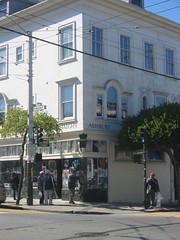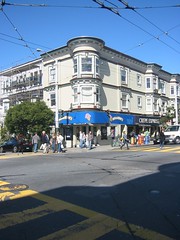This week's assignment is to talk about a place we like, using the concepts of Kelly Quinn and Jane Jacobs to describe why. This was an interesting exercise for me, because while our Jacobs reading made a lot of sense to me, I tend to enjoy parks and relatively isolated places (unsafe as they may be). However, in Kelly Quinn's lecture on Thursday, one thing that stuck out to me in particular was her description of the value of corners, which there are many of when your city is set on a grid. This brought to mind the most famous corner around: Haight and Ashbury.

Quinn said that the grid is the most democratic form of urban planning, and that at corners you connect with people who are unlike yourself. One of the things I like about Haight Street is the variety of people you encounter. You find tourists, locals, yuppies, hippies, poor people, wealthy people, young people, and old people, of all sorts of colors and orientations. Jacobs writes about good urban planning being a way to fight segregation and racism (she offers the example of someone in Los Angeles who had never actually seen a Mexican person). If we don't isolate communities from each other, they will interact and come to realize that their differences are superficial.
Jacobs wrote about the importance of eyes on the street in order to maintain safety. Haight Street is always bustling with activity, even until late at night. I would feel safer walking down Haight at night than I would walking back home through the quiet residential streets.

Another very important thing to Jacobs is the anonymity that cities offer. Residents don't want to be best friends with each other, but for a safe and stable environment, there needs to be a level of trust. To me Haight Street feels like it has more of a culture of trust than other busy city streets I know, perhaps because of the quantity of pedestrians and the fact that many of them are there for the sake of being there, rather than just passing through on their way somewhere else. They have a certain level of investment in the neighborhood.
No comments:
Post a Comment